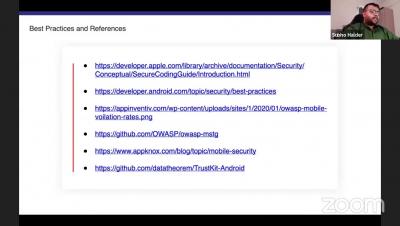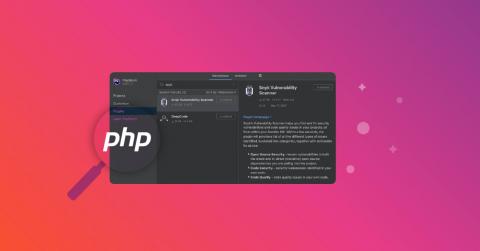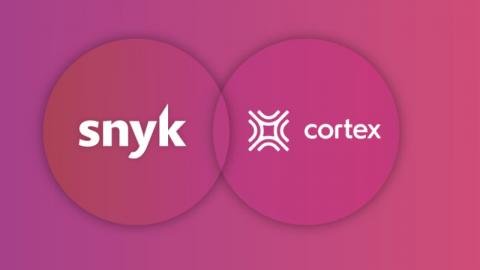Security | Threat Detection | Cyberattacks | DevSecOps | Compliance
June 2021
Optimizing software composition analysis for developer workflows with Black Duck Rapid Scan
Black Duck Rapid Scan enables developers to check for security or policy violations without disrupting development process. When the first software composition analysis (SCA) tools made their entrance into the market, their focus was on license compliance. As open source grew in popularity, SCA tools expanded to include vulnerability management, helping to reduce the attack surface for organizations leveraging open source.
5 ways to prevent PHP code injection
Following on from my previous post on testing for PHP Composer security vulnerabilities, I thought this post might be useful in helping create more secure applications that prevent PHP code injection. As developers, we build apps to help make end users’ lives easier. Be it entertainment, workplace or social network application, the end goal is to protect the users we build for by ensuring we build security into the code.
Too Many Vulnerabilities and Too Little Time: How Do I Ship the Product?
The percentage of open source code in the enterprise has been estimated to be in the 40 percent to 70 percent range. This doesn't make the headlines anymore, but even if your company falls in the average of this range, there is no dearth of work to do to clean up, comply with AppSec policies, and ship the product. Phew! So where do you start when it comes to resolving all the vulnerabilities uncovered in your open source libraries?
Zero Trust Architecture (ZTA) within LEXIS
To ensure Outpost24 stays at the forefront of cybersecurity technology we conduct regular research into new innovations, and LEXIS High Performance Computing (HPC) is one of them. Outpost24 was instrumental in contributing and providing the “Security-By-Design” and “Zero-Trust” principles to creating the secure LEXIS Cloud-HPC-Big Data platform, and in this blog we explore the zero-trust fundamentals for which the LEXIS portal has been designed.
Difference between Agent-based and Network-based Internal Vulnerability Scanning
Technology evolution is the only constant in our lives these days. Sometimes, an existing approach can go a long way in addressing problems, while other times, a new approach needs to be adopted to get the work done. Let’s talk about vulnerabilities; internal networks and software can be riddled with loopholes, which can expose them to breaches and data leaks, paving the way for hackers to have an easy ride.
Top vulnerability assessment and management best practices
By implementing these vulnerability assessment and vulnerability management best practices you will reduce the attack surface of your infrastructure. We’re human, and many things we build aren’t perfect. That’s why we take our cars for a periodic inspection, or why we have organizations certifying that products are safe to use. Software is no different.
Vulnerability Management with Sysdig
CyRC Vulnerability Advisory: Denial-of-service vulnerabilities in Zephyr Bluetooth LE stack
Eight vulnerabilities were discovered in Zephyr’s Bluetooth LE Stack using Defensics Bluetooth LE fuzzing solution.
Everything You Need to Know About Client-Side JavaScript Vulnerability Scanning
Welcome back to our five-part series on client-side security approaches. For those of you who are new to this series, there are five approaches to client-side security: In this blog I’m going to cover the use and limitations of vulnerability scanning for client-side security. Let’s start with the absolute basics. First, let’s take a deeper dive into a few key questions.
Automate remediation of threats detected by Datadog Security Monitoring
When it comes to security threats, a few minutes additional response time can make the difference between a minor nuisance and a major problem. Datadog Security Monitoring enables you to easily triage and alert on threats as they occur. In this post, we’ll look at how you can use Datadog’s webhooks integration to automate responses to common threats Datadog might detect across your environments.
Research Shows Over 100,000 Libraries Affected By Maven Vulnerability CVE-2021-26291
By Jonathan Leitschuh; Daniel Elkabes, Senior Security Researcher at WhiteSource; Ofir Keinan, Software Developer at WhiteSource The latest Maven release 3.8.1 contains a fix to security vulnerability CVE-2021-26291. Detected and reported by security researcher Jonathan Leitschuh, the vulnerability affects over 100,000 libraries in Maven Central, according to the WhiteSource security research and knowledge teams.
Malware hosting domain Cyberium fanning out Mirai variants
AT&T Alien Labs has observed the Mirai variant botnet, known as Moobot, scanning for known but uncommon vulnerabilities in Tenda routers, resulting in a considerable peak in our internal telemetry. The research associated with this peak resulted in the discovery of a malware hosting domain, providing several different Mirai variants, like Moobot and Satori.
Easily map Snyk vulnerabilities to Cortex services
Snyk is a developer-first, cloud native security platform that scans for vulnerabilities across code, dependencies, containers, and infrastructure as code. Snyk does a great job of surfacing vulnerabilities in your codebase, but it can often be challenging to map these issues back to actual services and their owners. Fortunately, Snyk’s robust API can be used to tune Snyk to integrate into solutions designed to help engineering teams understand and improve their service-oriented architecture.
A Look at a Zero Trust Strategy for the Remote Workforce
If you are new to the security world, it is fair to ask yourself, “Isn’t access to data and systems always conditional? Isn’t it always granted to someone who has access to the credentials (ID and password)?” True enough, but in totality, the approach to managing access encompasses a broader spectrum of privacy policies. These policies include a mix of different strategies that can be applied based on an organization’s security vulnerabilities.
Is Slack Secure? Vulnerabilities and Solutions
Slack has become one of the most integral platforms for businesses over the last decade, with more than 12 million users currently active. Despite its popularity, however, there are some Slack security concerns that linger from the platform’s 2015 security breach. Here’s what you need to know about Slack security and how to protect your sensitive information on the platform.
CVE-2021-31440: Kubernetes container escape using eBPF
In a recent post by ZDI, researchers found an out-of-bounds access flaw (CVE-2021-31440) in the Linux kernel’s (5.11.15) implementation of the eBPF code verifier: an incorrect register bounds calculation occurs while checking unsigned 32-bit instructions in an eBPF program. The flaw can be leveraged to escalate privileges and execute arbitrary code in the context of the kernel.
I can use VS Code to hack into your development environment
JBS Ransomware Attack Started in March and Much Larger in Scope than Previously Identified
SecurityScorecard also found that 1 in 5 of the world’s food processing, production, and distribution companies rated have a known vulnerability in their exposed Internet assets
CyRC Vulnerability Advisory: Denial of service vulnerabilities in RabbitMQ, EMQ X, and VerneMQ
CVE-2021-22116, CVE-2021-33175, and CVE-2021-33176 are denial of service vulnerabilities in three popular open source message broker applications.
Protecting Windows protected processes
This quick blog is the first in a two-part series discussing a userland Windows exploit initially disclosed by James Forshaw and Alex Ionescu. The exploit enables attackers to perform highly privileged actions that typically require a kernel driver.
Secure and manage open source risks in applications and containers with Black Duck SCA | Synopsys
Learn more about Synopsys Software Integrity: https://www.synopsys.com/software-integrity.html
Subscribe: https://www.youtube.com/synopsys
Follow Synopsys on Twitter: https://twitter.com/sw_integrity
The top 10 network security vulnerabilities for businesses in 2021
As per UK DCMS’s data breaches survey, about 32% of businesses in the UK have faced a form of cybersecurity threat between 2018 and 2019. As a result of these network security vulnerabilities, these businesses incurred costs on lost data and many other damages that totalled £4,180.
Mitigating and remediating intent-based Android security vulnerabilities
In previous posts we explored the potential for intent-based Android security vulnerabilities and then used Snyk Code to find exploits in popular apps on the Google Play store. If you know Snyk, you also know there’s no way we can just point out vulnerabilities and not recommend fixes. Analyzing such an extensive dataset enabled us to review a lot of code.
ITV #CISO on building a security culture and managing risk
We sat down with our customer - Deputy Group CISO at ITV, Jaspal Jandu who offers a practical view of today’s cybersecurity challenges including digital transformation, vulnerability management, risk prioritization and building a security culture from within.


























